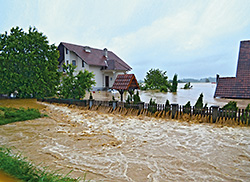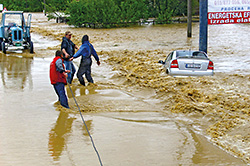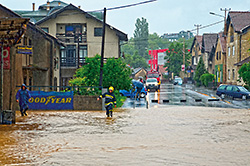Notebook
IN JADAR, THROUGH NEW FLOODS AND OLD STORIES
Four Days of the Flood
The People of Loznica have defended their city without must fuss about it, cameras and bad performances. People in this area have seen too many real horrible battles, they have died here ay much as they have breathed, so they cannot allow themselves to descend into something that trivial. And about 5,000 hectares were under water and as many households, with about 20,000 people. About 15,000 people were cut-off from the rest of the world, more than 2,000 were evacuated. And now? Life goes back into its regular flows slower than rivers into their beds
By: Goran Budimir
Photographs: Nebojša Trifunović and
”Lozničke novosti” (www.loznickenovosti.com)
 It looked like a typical spring trouble with water, and soon it started to turn into an apocalyptic screenplay. It poured down hard and continuously, so that almost everybody forgot when it had started. On Wednesday, May 14, in the area of Loznica, about 110 liters of rain fell per square meter. The Štira rivulet, whose beautifully developed and deep bed is winding through the city, swelled at a horrifying speed and flooded in the zone of the city market. It flooded Banjska street and settlement of Gradilište, in the zone of ”Viskoza”, dead chemical industry giant. Ploče is partially under water, as well as Voćnjak and Paskovac. Workers of ”Elektrodistribucija” of Loznica have been investing huge efforts to defend their central building and main transformer station, which supplies the entire town and the surrounding area. By eleven at night, about sixty workers were making embankment, in the rain, using the sand that was purchased by the company itself. It looked like a typical spring trouble with water, and soon it started to turn into an apocalyptic screenplay. It poured down hard and continuously, so that almost everybody forgot when it had started. On Wednesday, May 14, in the area of Loznica, about 110 liters of rain fell per square meter. The Štira rivulet, whose beautifully developed and deep bed is winding through the city, swelled at a horrifying speed and flooded in the zone of the city market. It flooded Banjska street and settlement of Gradilište, in the zone of ”Viskoza”, dead chemical industry giant. Ploče is partially under water, as well as Voćnjak and Paskovac. Workers of ”Elektrodistribucija” of Loznica have been investing huge efforts to defend their central building and main transformer station, which supplies the entire town and the surrounding area. By eleven at night, about sixty workers were making embankment, in the rain, using the sand that was purchased by the company itself.
News about this hadn’t reached far yet, and new ones began to arrive on internet portals and social networks. like a flood. The hospital creek in Klupci, Šački potok in Lešnica, Cernica in Donja Badanja. Everything flooded, and the tide is penetrating the settlements. Water levels of the Jadar and Drina are getting dangerously high. The same news, of course, flew into the city headquarters. The rain kept pouring down. The decision to proclaim the state of emergency could not be postponed any longer. And all available mechanisms included in this had to be activated immediately.
Later that evening the Jadar went amok. It broke through the embankment in the village of Kozjak, and spilled over a large field.
And the rain kept pouring down, incessantly, not getting any weaker, and the big drama was only about to begin. The gendarmerie arrives in Loznica, rescue teams and experts of the Sector for Emergency Situations of the Serbian Ministry of the Interior.
BIG SILENT DEFENSE OF THE CITY
 In the night between Wednesday and Thursday, May 14-15, the Jadar’s tantrum continues. The bridge in the village of Draginac is severely damaged. Experts warn that there is a danger that the bridge would collapse, obstruct the way to the swollen river and cause a disaster. In the night between Wednesday and Thursday, May 14-15, the Jadar’s tantrum continues. The bridge in the village of Draginac is severely damaged. Experts warn that there is a danger that the bridge would collapse, obstruct the way to the swollen river and cause a disaster.
”A few hundred meters after the bridge, on Karlagan, the water interrupted traffic on the road Loznica–Valjevo”, Lozničke novosti reported. ”The Jadar continues to run amok toward all villages in its basin. The flood is spreading from Cikot, Draginac, Veliko Selo, Bradić, Upper and Lower Dobrić, Straža, Lipnički Šor, to Jelav and Lešnica. And all tributaries and creeks spilled out of their beds.”
At dawn, because of the danger that the swollen water would penetrate, an important transformer station 110 in Lešnica was switched off. About thirty thousand people were left without electricity, as well as a wide area from the edge of Lipnički Šor almost to the entrance into Šabac.
In the morning in Loznica, after the sleepless night, we learn that he following roads were blocked: Loznica – Mali Zvornik (it was only possible to pass via Koviljača), Loznica–Šabac (near Jelav), Lipnički Šor – Tekeriš, Kozjak–Lipnica, Bradić – Veliko Selo. It was not possible to enter Draginac either from the Valjevo road or from Veliko Selo.
We receive an e-mail from Zvornik: ”Water flow on the dam of the Hydro Power Plant is six times bigger than normal. We can no longer keep all this water, because we are jeopardizing stability of the dam and risking a real disaster. We have to drastically increase the water discharge.”
 Great defense of the city begins in Loznica. The main line where the people of Loznica go out is undefended part of the bank on the Bypass. Over ten thousand sandbags were mounted by Thursday evening on the critical section, Without fuss and circus, without cameras and bad performances. People in this area have seen too many real horrible battles, they have died here ay much as they have breathed, so they cannot allow themselves to descend into something that trivial. Great defense of the city begins in Loznica. The main line where the people of Loznica go out is undefended part of the bank on the Bypass. Over ten thousand sandbags were mounted by Thursday evening on the critical section, Without fuss and circus, without cameras and bad performances. People in this area have seen too many real horrible battles, they have died here ay much as they have breathed, so they cannot allow themselves to descend into something that trivial.
At the same time, the most vulnerable people were being evacuated. The main shelter was in ”Lagator”. We visit the people and bring aid. The notebook is being filled with stories that can be found all over Serbia those days and nights. The same words and descriptions, the same tears and the same brave heart.
Based on the estimates of the headquarters in Loznica, about 5,000 hectares of arable land are under water and as many households, with about 20,000 people. In this moment, because the traffic is blocked, about 15,000 people in Loznica region are cut-off from the rest of the world. About one hundred people are in the shelter, more than 2,000 evacuated people found accommodation with family and friends.
BREAKING INTO KRUPANJ
 A new morning in the town under Gučevo. The Jadar region is still soberly withstanding the disaster, without any surplus. Without surplus of words, to much wining and theatricality. There are no crowds of people in the stores, no exaggerating in searching for help. Alas, the people of the Jadar are experienced in this. Of course, help is necessary. They know what is needed and where. Quietly, people bring as much as they can, nobody is in a great position, but the charity warehouses are being filled quickly. The most basic items are there. A local correspondent of a newspaper from the capital, known for market prices and nameless office reporting, published that the merchants in the town tripled the prices of water and some other staple food products. This misinformation seriously angered the people of Loznica. There is no shortage of water, but that morning the well informed correspondent disappeared, at least for a while. A new morning in the town under Gučevo. The Jadar region is still soberly withstanding the disaster, without any surplus. Without surplus of words, to much wining and theatricality. There are no crowds of people in the stores, no exaggerating in searching for help. Alas, the people of the Jadar are experienced in this. Of course, help is necessary. They know what is needed and where. Quietly, people bring as much as they can, nobody is in a great position, but the charity warehouses are being filled quickly. The most basic items are there. A local correspondent of a newspaper from the capital, known for market prices and nameless office reporting, published that the merchants in the town tripled the prices of water and some other staple food products. This misinformation seriously angered the people of Loznica. There is no shortage of water, but that morning the well informed correspondent disappeared, at least for a while.
Daily press did not reach Loznica this morning. The degree of hygiene in the affected city time is thus significantly raised, and danger of infection reduced. In addition to the Drina, other waters are not rising today, but there are too many of them anyway. They are looting. By car and by tractor we somehow manage to push to the edge of Kozjak toward Upper Dobrić, to check the condition of the bridge. The news was vague and contradictory. We are assured that the bridge is still there, but the Jadar broke through the regional road toward Tekeriš, actually access to the bridge, from the Kozjak side. Next to the riverbed, through the field, on the outer side of the embankment, another stream is gushing. On the other side, the field is filled with water all the way to the foothill of Iverak. Houses flooded ”to the first slab”. It is the same when you look toward Bradić, Lipnica, Jelav.
 We go back and confirm that the road toward Tekeriš is blocked, and there between Kozjak and Upper Dobrić, and in Joševa, where the Lešnica Creek had spilled. We go back and confirm that the road toward Tekeriš is blocked, and there between Kozjak and Upper Dobrić, and in Joševa, where the Lešnica Creek had spilled.
Cries for help come to Loznica from all over, pleas for evacuation of babies, sick people, trapped people. ”The city only has three boats and two freight vehicles available!” Lozničke novosti report. (Website and Facebook page of this local paper have an important role in informing and recruiting people, sending rescue teams and aid.) The army does not have enough people. It took almost all of them out of Loznica and transferred them to the ”more affected points”. More Serbian soldiers remained in the city eve under the Austro-Hungarian occupation.
On Friday, May 16, people from the Sector for Emergency Situations in Loznica manage to break through Stolice and Brštica, on foot, through forests and hills, to the destroyed Krupanj. The yare first to enter the town and bring aid, and take out truth about the scale of the disaster. They return on foot, down the same road, and alarm the population. The unfortunate little town, without electricity and water, without road connection with the world, in the silly media blockade, is finally illuminated with a ray of light. Loznica is organizing transport of the rescuers, giving some machinery, although it does not have enough of it itself. The hank is being unfolded. Then the images that everybody knows today will stream out. Destroyed and knocked over houses next to which every self-respecting politician will stop to take a photograph.
IT TAKES STRENGTH TO WATCH
 Third day of the disaster. The waters are calming down, the skies are getting dry. At seven in the evening everybody has electricity again, those in Lešnica the last among them. We arte passing through Jelav, we see that the traffic is resumed on main road Šabac–Loznica. The Jadar will not return to its bed that soon. or life back to its usual flow. It takes strength to look left and right from the road. Third day of the disaster. The waters are calming down, the skies are getting dry. At seven in the evening everybody has electricity again, those in Lešnica the last among them. We arte passing through Jelav, we see that the traffic is resumed on main road Šabac–Loznica. The Jadar will not return to its bed that soon. or life back to its usual flow. It takes strength to look left and right from the road.
On the other side, in Cikote, on the road to Valjevo, villages near the Jadar look like after an unknown Armageddon. The banks are torn, broken off, thick deposits of sludge covering the farmland, tree stumps, all kind of debris that the tide drags along with it. A little further away, we take an old man into our car, Milivoje, he says. He goes to Zavlaka, looking for a veterinarian. Hs cow, in calf, is not feeling well. He is worried, looking through the window.
– What happened here, son?
– I don’t know, old man. I don’t know.
We are silent. Whatever you say is small talk. And like this we understood each other well and said a lot.
In Zavlaka he thanked us, have us an apple, and got off. Went down the road toward Badanja.
 A few das later, in Loznica, mayor Vidoje Petrović tells for the local media: A few das later, in Loznica, mayor Vidoje Petrović tells for the local media:
– Based on current information, the amount of damages is estimated at 1.6 billion dinars. It is almost the annual budget of the city of Loznica. I am afraid that the amount will be even bigger, because the flood destroyed roads, bridges, there are serious damages on houses, landslides became active, households in flooded houses can no longer be used. We have had floods of unprecedented scale. In the first wave, the Štira ran amok, it had unprecedented water level. The Jadar also reached its historical maximum. In the regulated part of this river, in the late 1980’s, an embankment was made based at the level of ”century-old water”. Four years ago we reconstructed the embankment and raised it by an additional meter. And now. in May of 2014, in the region of Kozjak, in immediate vicinity of the bridge toward Upper Dobrić, the Jadar exceeded even that level. Then it started flooding. Things were getting more complex by the minute. The city headquarters engaged all of its resources from the every beginning, both human and material. We managed, as much as possible in a situation like this, to protect what was the e highest priority in those moments, and what could be defended.
***
There is No Help
– We are doing our best. First we focused on remedying the road network, and fixing the bridges. In some places, like in Draginac, we have to build new ones – says mayor of Loznica Vidoje Petrović. – Unfortunately, the tragedy that befell us is not sufficiently visible. The entire Serbia was hit and everyone thinks their pain is the worst. We will not compete in this, but about twenty thousand people who suffered damages here deserve to have this seen and to be helped. We are asking for more help, as much as possible, because it does not arrive in Loznica.
***
In Time
– All waters from the surrounding areas, and the consequences, are draining here where we are – adds mayor Petrović. – Fortunately, in the past three years we did a lot together with ”Srbijavode” on the network of channels and river flows. That is why the water withdrew so quickly here, and only some smaller pockets remained. This is the lesson for all of us to invest more and more promptly into this area.
|
